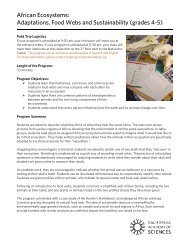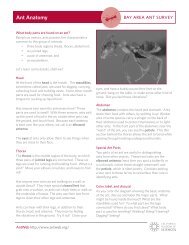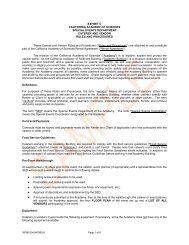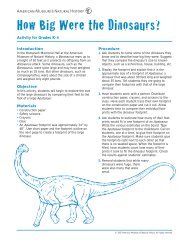Squawk of the town: Academy receives Platinum rating - California ...
Squawk of the town: Academy receives Platinum rating - California ...
Squawk of the town: Academy receives Platinum rating - California ...
Create successful ePaper yourself
Turn your PDF publications into a flip-book with our unique Google optimized e-Paper software.
Military Macaw<br />
With its flashy tail fea<strong>the</strong>rs and<br />
riotously colorful face, <strong>the</strong> Military<br />
Macaw (Ara militaris) is easy to<br />
spot—but it’s even easier to hear. This<br />
gregarious parrot lives in groups <strong>of</strong><br />
20 to 40 birds, and <strong>the</strong> boisterous<br />
calls it uses to communicate with<br />
o<strong>the</strong>r members <strong>of</strong> <strong>the</strong> flock<br />
<strong>of</strong>ten travel considerable<br />
distances. Like o<strong>the</strong>r<br />
parrots, Military Macaws<br />
possess <strong>the</strong> rare ability<br />
to learn and produce new<br />
vocal sounds by mimicking<br />
<strong>the</strong> sounds around <strong>the</strong>m,<br />
including human words.<br />
Recent brain volume studies have<br />
shown that primates and parrots have<br />
similar relative brain sizes.<br />
In <strong>the</strong> wild, Military Macaws feed<br />
mostly on seeds, nuts, and fruits.<br />
However, <strong>the</strong>ir diet also includes<br />
ano<strong>the</strong>r surprising ingredient—mineralrich<br />
clay. Each morning, <strong>the</strong> birds visit<br />
heaps <strong>of</strong> clay called “macaw-licks”<br />
and consume a few grams <strong>of</strong> clay. By<br />
analyzing soil samples from several<br />
Peruvian macaw-lick sites, scientists<br />
have found that this clay has <strong>the</strong> ability<br />
to absorb large quantities <strong>of</strong> alkaloid<br />
quinine, a toxin that occurs naturally<br />
at low levels in most parrot diets. The<br />
clay also increases mucus secretion,<br />
fur<strong>the</strong>r protecting <strong>the</strong> stomach lining<br />
from dietary toxins. Once <strong>the</strong>y’ve had<br />
<strong>the</strong>ir daily dose <strong>of</strong> clay, <strong>the</strong> macaws are<br />
able to eat larger quantities <strong>of</strong> seeds and<br />
fruits that would o<strong>the</strong>rwise make <strong>the</strong>m<br />
sick.<br />
Military Macaws typically live<br />
for 50 or 60 years, and in captivity<br />
<strong>the</strong>y can survive even longer. After<br />
<strong>the</strong>y reach sexual maturity, <strong>the</strong>y form<br />
monogamous pair bonds that <strong>of</strong>ten last<br />
for <strong>the</strong> duration <strong>of</strong> <strong>the</strong>ir lives.<br />
Creature Closeup<br />
Where in <strong>the</strong> World<br />
Military Macaws occupy a large but<br />
highly fragmented range from Mexico<br />
to Argentina. Over <strong>the</strong> past 50 years,<br />
<strong>the</strong>ir population numbers have declined<br />
dramatically, mostly due to habitat loss<br />
and <strong>the</strong> pet trade. Current estimates<br />
place <strong>the</strong> wild population at around<br />
10,000 birds. They are now listed as<br />
Vulnerable by <strong>the</strong> International Union<br />
for Conservation <strong>of</strong> Nature.<br />
Where in <strong>the</strong> <strong>Academy</strong><br />
The <strong>Academy</strong>’s pair <strong>of</strong> Military Macaws<br />
spend <strong>the</strong>ir days perched on a Madrone<br />
tree in <strong>the</strong> Rainforests <strong>of</strong> <strong>the</strong> World<br />
exhibit. At night, an <strong>Academy</strong> biologist<br />
takes <strong>the</strong>m to a special holding room<br />
behind-<strong>the</strong>-scenes to make sure <strong>the</strong>y<br />
get a good night’s sleep.<br />
House Hunters<br />
Ra<strong>the</strong>r than building <strong>the</strong>ir own nests,<br />
<strong>the</strong>se birds look for hollows inside tree<br />
trunks or cavities in <strong>the</strong> face <strong>of</strong> a cliff<br />
wall. When forests are logged, <strong>the</strong><br />
macaws lose valuable nesting sites.<br />
Prized Possessions<br />
Because <strong>of</strong> <strong>the</strong>ir colorful plumage,<br />
Military Macaws have been valued by<br />
humans for thousands <strong>of</strong> years. Their<br />
blue-green tail fea<strong>the</strong>rs were highly<br />
prized by a number <strong>of</strong> Pre-Columbian<br />
civilizations, including <strong>the</strong> Olmec,<br />
Maya, and Inca, and <strong>the</strong>ir bones have<br />
been found in archaeological sites<br />
dating back to 1200 BC or earlier.<br />
Photo: Olivier Laude<br />
calacademy.org 5



![download [PDF - 2.7mb] - California Academy of Sciences](https://img.yumpu.com/26596748/1/190x122/download-pdf-27mb-california-academy-of-sciences.jpg?quality=85)








![Download a visitor map [418k] - California Academy of Sciences](https://img.yumpu.com/26596645/1/190x88/download-a-visitor-map-418k-california-academy-of-sciences.jpg?quality=85)



